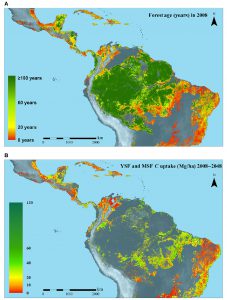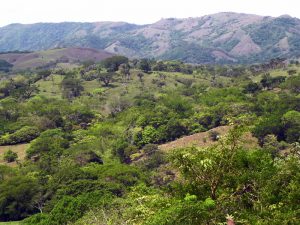
TUSCALOOSA, Ala. – For decades, scientists have warned politicians about global warming, often to no avail.
But with global temperatures steadily climbing year after year, polar ice caps melting, sea levels rising and severe weather becoming more frequent, denying the evidence of global warming has become increasingly difficult and the majority of world leaders – 54 percent – have recognized that it’s a serious problem, according to a 2015 PewResearchCenter study.
With that realization came a call for solutions.
On Friday, May 13, Science Advances, one of the world’s top, multidisciplinary, highly selective, online-only research journals, published an article about how much carbon dioxide – the primary greenhouse gas that causes global warming – in the atmosphere can be reduced by natural regrowth of secondary forests in the Latin America neotropics.
Natural unassisted secondary forest regeneration can occur in abandoned areas after an old-growth forest has been cut down. An old-growth forest is a forest of native trees that’s been mostly undisturbed by man.
A total of 60 scientists from throughout Latin America and the United States wrote the research article, titled “Carbon Sequestration Potential of Second-Growth Forest Regeneration in the Latin American Tropics.”
Two of the authors are geography professors from The University of Alabama’s Spatial Ecology and Conservation Lab: Dr. Eben Broadbent, an assistant professor who is listed as second author on the article – a ranking system showing the amount of work each author contributes – and Dr. Angelica Almeyda Zambrano, an adjunct professor who is listed as fifth author.
Broadbent said if policymakers want information on how much carbon dioxide could be absorbed by secondary forests in their countries in the next 40 years, this study is the key.
“That’d be the question they want to know,” he said. “And in order to answer that question you’d need to ask, ‘Well, what is the current state of your country? Is it all primary old-growth rainforests, or is it all pasture?’ That is the key to the question, understanding that.
“So we took maps that show the initial state of forests across the entire neotropics, and we can do that with any current policymakers’ country. Then we use the current reality of what the forests were in order to say how much carbon could your country right now will take up in the future.
“In doing this in Latin America, we’ve created the very first map of forest age across the entire neotropics, which is also something that’s pretty exciting.”
Humans are responsible for the carbon dioxide emissions in the atmosphere. It’s caused when fossil fuels such as coal, oil and natural gas are burned. Trees, however, counter this pollution by absorbing the carbon in the atmosphere during photosynthesis and incorporate it into the woody parts of the plant. They then emit O2, which is breathable oxygen.
Broadbent said this is why they believe secondary forest regrowth is a strong counter to global warming and a measure that policymakers should put in place.

“A young secondary forest can take carbon out the atmosphere up to 11 times faster as an old growth forest,” he said. “They’re doing a better job of sequestering the carbon from the atmosphere because they need to grow just like a young, growing child needs to eat more.”
Broadbent and Almeyda Zambrano started working on the study last summer in Costa Rica, including data from 10 years of research on the natural rate of recovery of secondary forests in the neotropics of Latin America after deforestation. The work included data from that study, “Biomass Resilience of Neotropical Secondary Forests,” which was published in the journal Nature on Feb. 3, 2016.
Broadbent said the two studies go hand-in-hand.
“What we did with the first study is we took our understanding about how fast secondary forests regrow and converted it to a very real amount of carbon that could be uptaken in the future across the entire neotropics,” he said.
The geography department is part of UA’s College of Arts and Sciences, the University’s largest division and the largest liberal arts college in the state. Students from the College have won numerous national awards including Rhodes Scholarships, Hollings Scholarships and Goldwater Scholarships.
Contact
Jamon Smith, UA media relations 205/348-4956, jamon.smith@ua.ed
Source
Dr. Eben Broadbent, 650/204-1051, eben@ua.edu; Dr. Angelica Almeyda Zambrano, 650/204-1052, angelica@ua.edu